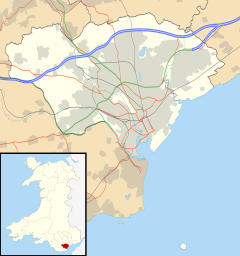Radyr
Radyr
| |
|---|---|
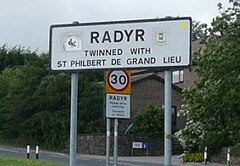 Radyr street sign | |
Location within Cardiff | |
| OS grid reference | ST1380 |
| Community | |
| Principal area | |
| Preserved county | |
| Country | Wales |
| Sovereign state | United Kingdom |
| Post town | Cardiff |
| Postcode district | CF15 |
| Dialling code | 029 |
| Police | South Wales |
| Fire | South Wales |
| Ambulance | Welsh |
| UK Parliament | |
| Senedd Cymru – Welsh Parliament | |
Radyr (
History
Stone Age until the Norman Conquest
Evidence of
Origin of the name
Hints about the derivation of the name Radyr can be found in Lifris's writings Life of St Cadog, written between 1081 and 1104 but relating to the earlier period around AD 530, which mentions a croft or tref on the site called Aradur Hen. Lifris also tells the story of Tylyway, a hermit who was held to have lived on the banks of the Taff. Tylyway's cell is the most likely origin of the name Radyr; from the Welsh yr adur, meaning "the chantry", although Arudur Hen is also possible.[3]
Norman occupation and Middle Ages
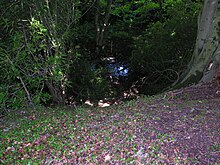
The Norman
Mathew family

In 1469 Thomas Mathew (died 1469), the third or fourth son of
Sir George created a
Stuart period
Radyr's new owner was a wealthy landowner, Sir Edward Lewis,
A survey in 1766 shows that the Plymouth family owned the freeholds of most of Radyr. It continues to do so today. Plymouth Estates sold 22 acres (9 ha) of residential land in Radyr in 2007.[12]
Development from the 18th century
Many residents of Radyr worked in the Melingriffith Tin Plate Works, on the other side of the River Taff in Whitchurch.[13] The works opened in 1749 and closed in 1957.[14]
Samuel Lewis' 1849 Topographical Dictionary of Wales says of Radyr:[15]
"A parish, in the poorlaw union of Cardiff, hundred of Kibbor, county of Glamorgan, in South Wales, 3½ miles (N. W. by W.) from Cardiff; containing 279 inhabitants. This parish probably derives its name, signifying "a cataract," from the rushing waters of the river Tâf, by which it is bounded on the north-east. It was formerly comprehended within the hundred of Miskin, but has been recently separated therefrom. It comprises about eleven hundred acres of arable and pasture land, inclosed and in a profitable state of cultivation: the surface is in some parts elevated, and in others flat, but no where subject to inundation; the soil is a strong brown earth, favourable to the production of good crops of grain of all kinds, potatoes, and hay. The substratum is partly a hard brown stone, and partly limestone of very good quality. Radyr Court, formerly the seat of the family of Matthew, ancestors of the late Lord Llandaf, has been partially taken down, and the remainder has been modernised, and converted into a farmhouse. The turnpike-road leading from Cardiff to Llantrissent passes a little to the south of the parish; and the Tâf-Vale railway runs through it, nearly parallel with the river, which is crossed by the line in this vicinity. Some of the inhabitants are employed at the iron-works in the parish of Pentyrch.
The living is a vicarage, endowed with £200 royal bounty; patron and impropriator, the representative of the late Earl of Plymouth, who is lord of the manor: the tithes have been commuted for £113. 9s. 0d, of which a sum of £38. 9s. 0d is payable to the impropriator, and a sum of £75 to the vicar. The church, dedicated to St. John the Baptist, is a neat plain edifice, with a curious turret at the west end. There is a place of worship for Calvinistic Methodists; a Sunday school for gratuitous instruction is held in it, and another at Radyr Court. In the parish is a spring of very cold water, called Y Pistyll Goleu, "the bright water-spout," issuing from the side of a hill, under a considerable depth of earth over a limestone rock: it has by some writers been termed mineral, but it is not known to possess any other properties than that of its extreme coldness, which renders it efficacious in curing sprains and weakness of the sinews."
Until the mid 19th century Radyr was a collection of small farms, crofts and cottages, but after
Wartime
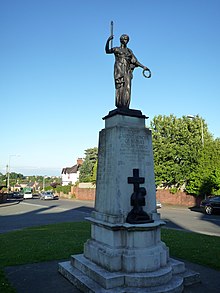
In the First World War the community raised funds for a "Radyr bed" at the nearby Welsh Metropolitan Military Hospital in Whitchurch and established a "Citizen Guard" made up of those too old or too young to enlist.[3] Losses suffered by the village are recorded on the War Memorial in Heol Isaf.
In the Second World War thousands of children were evacuated from metropolitan areas such as London, Birmingham and Liverpool. One evacuee from Woolwich, Patricia Armstrong aged nine, was knocked down by a passenger train and killed on a Saturday afternoon in May 1943 while using the Gelynis foot crossing at Morganstown. She was lodged with a family in Morganstown.[18] As air raids on Cardiff increased, even younger children from Radyr were evacuated to boarding schools at Rhoose and Bridgend.[19]
Post-war history
An extensive housebuilding programme started in the 1960s, and Radyr's population grew rapidly — particularly children. In 1964 Radyr Comprehensive School had 135 pupils on its roll. This number more than trebled in the next decade.[3] A new development, the Danescourt estate, was built on land surrounding Radyr Court and St John the Baptist parish church, and the land was officially incorporated as a suburb of Cardiff in 1974.[20] Danybryn Woods, near the development, was retained as the entire forest is protected by a tree preservation order and is home to many species of plants and wildlife.[21] Radyr railway station was renovated in 1998 and the tracks through the station were renewed, reducing journey times to Cardiff city centre.[20]
In 2017 construction started on the first phase of a new Cardiff suburb of 7,000 houses, named Plasdwr, on countryside along the Llantrisant Road between Radyr and St Fagans.[22]
Governance
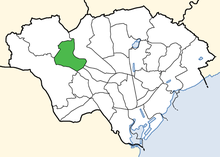
UK Parliament and Senedd
Radyr is in the
Cardiff Council
Community Council
Radyr and Morganstown Community Council is funded by an addition to the Council Tax bill paid by local residents.[24] The Community Council is run by 11 elected councillors from three wards in the parish – Radyr North (4 seats), Radyr South (3 seats) and Morganstown (4 seats)[25] - subsequently increased to 12 councillors (4:4:4).
Geography
Geological structure
The surrounding soils are mostly a strong, brown, dry earth, well adapted for arable farming and the growing of grains of all kinds that contributed to the area being a mostly farming community until the modern era. Soils were further enriched over the millennia by
Radyr Weir

The River Taff at this point runs roughly south through Taff's Well, past Radyr and through Llandaff.
Radyr Weir was built in 1774 to divert water into a leat to the Melingriffith Tin Plate Works.[3] The weir is the third obstacle to migratory salmon and sea trout — the others being Llandaff Weir and Blackweir, both of which also have fish passes.[28] Since the early 1980s, the salmon and sea trout stocks in the Taff have been recovering from nearly 200 years of industrial pollution and exploitation.[29] In 1993 the National Rivers Authority monitored over 500 salmon and 700 sea trout returning to the river to spawn.[30]
From 1749, iron from Pentyrch was initially transported to the works using pack-horses, then tub boats were used on the Taff passing onto the feeder via a lock at Radyr Weir. Parts of this lock can still be seen beside the feeder sluice. In 1815 the tub boats were discontinued and a tramway built along the Taff.[30] There is a public picnic site by the Radyr weir.

A hydro-electric scheme was built in 2016 on Radyr Weir to generate renewable energy. The Radyr Weir scheme channels more than 500 million cubic metres of water per year through two screw turbines and is expected to generate 400 kW — enough energy to power three of the city’s leisure centres — which will save 700 tonnes of CO2 annually.[31][32]
The River Taff through Radyr is flanked on both sides by an undeveloped greenway that passes uninterrupted through northern Cardiff all the way to Cardiff Castle in the centre of the city, before the river enters Cardiff Bay.
Radyr Woods Nature Area
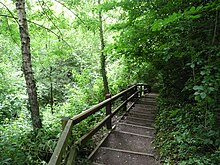
Radyr Woods is a
Radyr Woods provides habitats for a wide range of species. It also has a number of natural springs that feed a duck pond and a
Radyr hawkweed
Radyr hawkweed is the common name of

In the first survey of 1998, only nine plants were identified in one single Radyr garden, where it traditionally grew on grassy banks and lawns, often in shade. It was no longer found at the original locality of Radyr Quarry where examples were last seen in 1985. At Bridgend, six possible plants of the Radyr genus were found on an old garden wall, but confirmation of identification is still awaited.[39]
Neither the species nor the sites have any current legal protection, and it could be under significant threat of survival in the long term from inappropriate gardening or care.
Demography
| Year | Population of Radyr | Change |
|---|---|---|
| 1801 | 196 | – |
| 1811 | 106 | -46% |
| 1821 | 128 | 21% |
| 1831 | 227 | 77% |
| 1841 | 279 | 23% |
| 1851 | 417 | 50% |
| 1881 | 519 | 24% |
| 1891 | 610 | 18% |
| 1901 | 816 | 34% |
| 1911 | 1,238 | 52% |
| 1921 | 1,634 | 32% |
| 1931 | 1,586 | -3% |
| 1951 | 1,568 | -1% |
| 1961 | 1,690 | 8% |
| 2001 | 4,658 | 176% |
| 2009 | 6,000 | 29% * |
| source: Vision of Britain except *, which is estimated by the Office for National Statistics. Historical populations are calculated with the modern boundaries | ||
The 2001 census showed that the suburb had a total population of 4,658, of whom 2,268 were male and 2,390 were female. The average age was 39.7 years. 68.27% of [adult] residents are married, with 20.81% having never married. 73.97% declared their religion as Christianity. 23.97% stated no religion and 0.9% stated Muslim. 96.02% stated their ethnicity as white, 1.76% as Asian, 1.03% as mixed race, 1.01% as Chinese, and 0.2% as Black. 15.5% are Welsh language speakers.[40]
Landmark buildings and local attractions
Danybryn Cheshire Home was once a private house owned by Sir Lewis Lougher
The
Education
The Church Rooms in Park Road were also a primary school until 1896 when the Board School was opened next door. Older pupils had to travel to secondary schools in
Nursery and primary schools
Bryn Deri Primary School was opened in 1976 and has included a
Radyr Primary School in Park Road opened in 1896, and new classrooms were added in 1968 to accommodate the rising population. The school currently has 11 classes and over 300 pupils.[47]
Secondary education
Churches

The
Christ Church, although a larger building than St John's, is the daughter church in Radyr. Designed by the Llandaff diocesan surveyor George Halliday, the nave was ready for use at Easter 1904 and the chancel and tower were completed in November 1910.[41] Also in 1910 John Taylor & Co of Loughborough cast a ring of eight bells for the tower.[52] Lieutenant Colonel Fisher paid for the bells, and each bell is inscribed with the names of members of his family.[13]
Radyr
Sport and leisure

Llandaff North RFC is the closest rugby team to Radyr. Nearby Taffs Well RFC was formed in 1887, and has provided three former Welsh Rugby captains and six Welsh International players during its history.[54]
Radyr Golf Club was founded in 1902 after moving from its original nine-hole course at the Tŷ Mawr in Lisvane. It is a 6,109 yards (5,586 m), par 70 (SSS 70) course for men and 5,510 yards (5,040 m), par 73 (SSS 73) for women, and operates all year round.[55] Laid out by the course designer Harry Colt,[56] the Chairman of the 2010 Ryder Cup recently described Radyr's course as "One of Colt's Little Jewels".[55]
Radyr Lawn Tennis Club was founded in 1914 by 20 Radyr 'Gentlemen', helped by the Earl of Plymouth Estates. Its first location was near the railway station but the courts were badly laid. Again with the help of Plymouth Estates, the club lifted the turf from all three grass courts and relaid it on its current site next to Christ Church on Heol Isaf.[57]
Radyr Cricket Club was founded in 1890 by the Earl of Plymouth, who granted a hundred-year lease for the current riverside ground to the local residents for a nominal sum. The pavilion was destroyed by fire in 1973 while the team were away on tour. Under the leadership of the new Chairman Keith Terry, a huge fund-raising effort was made and a new pavilion opened on the footprint of the old one in 1975. Radyr currently plays in the first division of the South Wales Premier Cricket League.[58]
Cardiff Corinthians Football Club (known locally as the "Corries") has played its home games at the Riverside Football Ground in Radyr since 1974 and competes in the first division of the Welsh Football League.[59]
The main shops in Radyr are in Station Road. One of the buildings on this road, Bryn Melyn, is now a dental surgery but was formerly the village post office.[13]
Transport
Rail
At the turn of the 20th century Radyr had a busy railway from where
Radyr railway station still handles significant traffic, with over 200 trains calling each weekday and more than 400,000 passenger journeys per year.[61][62] Radyr is the northern terminus of the Cardiff City Line.
Bus
Cardiff Bus route 63 and Stagecoach South Wales route 122 operate from Morganstown and Radyr to Cardiff Central bus station via Danescourt, Llandaf and Pontcanna.[63]
Road
The B4262 road (Heol Isaf) runs through the centre of Radyr and Morganstown, leading north to Taff's Well and the A470 towards Pontypridd, and south to the A4119 (Llantrisant Road), which links Llantrisant with Danescourt, Llandaff and Cardiff city centre.
The M4 corridor around Cardiff was announced in 1971 as a replacement for a northern link road that had been planned since 1947 but never built.[64] The northern "Lisvane and Radyr route" for the M4 was eventually chosen after a number of noisy public enquiries and active objections by residents from both communities.[65] The new motorway was completed and opened on 10 July 1980,[65] and passes east–west between Radyr and Morganstown. Later this section was widened to three lanes in each direction at a cost of over £71 million, being completed in December 2009.[66] Radyr has no direct access to or from the motorway.
Notable people

Several notable people are associated with Radyr. The children's author Roald Dahl (1916–90) lived in the 1920s at a house called Tŷ Mynydd in Radyr (which was demolished in 1967).[13][67] He called it an "imposing country mansion, surrounded by acres of farm and woodland" in his book Boy: Tales of Childhood.[68] Jimi Mistry (born 1973), who is an Asian-British actor and appeared in EastEnders, The Guru and East Is East, attended Radyr Comprehensive School.[69] Actor Harry Ferrier also went to Radyr Comprehensive as he grew up in Radyr.[70] and Tess Griffiths (Nee Davies).
Local sportsmen include
Another notable resident is
Radyr in the media
The outdoor scenes in an episode of the TV science fiction series Torchwood, called Small Worlds, were filmed mostly around Radyr Primary School.[77]
References
- ^ "Area: Radyr and Morganstown (Parish); Key Figurs for 2011 Census: Key Statistics". Neighbourhood Statistics. Office for National Statistics. Archived from the original on 7 February 2012. Retrieved 16 June 2013.
- JSTOR 298662.
- ^ ISBN 0-9514887-4-0. Archived from the original(PDF) on 19 July 2011.
- ^ "Morganstown Motte". Retrieved 19 June 2008.
- Sir David Mathew(died 1484), the second of Sir Christopher Mathew (died 1527), eldest son of Reyborne Mathew, second son of Sir David
- ^ Davies, J. Barry. "Friends of Llandaff Cathedral 2003 annual lecture". Friends of Llandaff Cathedral 71st annual report 2003/4. Archived from the original on 7 August 2013.
- ^ Welsh, Sarah (1 May 2004). "Court in the Act". South Wales Echo. Retrieved 20 April 2009.
- ISBN 978-0-7083-1264-3.[page needed]
- ^ "Mathew of Thurles". Archived from the original on 5 January 2009. Retrieved 28 June 2008.
- ^ Matthews, John Hobson, ed. (1900). "The manors of Cardiff district: Descriptions". Cardiff Records. Vol. 2. London: Institute of Historical Research. pp. 8–41.
- ^ "LEWIS family, of Van, Glamorganshire". Dictionary of Welsh Biography. National Library of Wales. Retrieved 5 May 2009.
- ^ "Property Profile 2007" (PDF). 2007. Archived from the original (PDF) on 5 July 2008. Retrieved 28 June 2008.
- ^ ISBN 0-9514887-6-7. Archived from the original(PDF) on 19 July 2011.
- ^ Pride, W.E. (30 July 1957). "It's goodbye to Griffith's Mill". Western Mail. Archived from the original on 21 April 2009. Retrieved 5 May 2009.
- ^ Lewis, Samuel (1849). "Radyr – Rhuddlan". A Topographical Dictionary of Wales. London: Samuel Lewis & Co. pp. 345–356.
- ISBN 978-1-85794-249-1.
- ^ "Population Statistics for Radyr". Retrieved 28 June 2008.
- ^ Strange, Keith. "Cardiff Schools & The Age of the Second World War". p. 179. Archived from the original (DOC) on 10 December 2006. Retrieved 14 May 2011.
- ^ Strange, Keith. Cardiff schools and the age of the Second World War. p. 15. Retrieved 5 May 2009.
- ^ a b "The Suburbs and Radyr and Morganstown". Cardiffians. Retrieved 19 April 2011.
- ^ "Danybryn Woods". Radyr & Morganstown Community. Archived from the original on 19 July 2011. Retrieved 19 April 2011.
- ^ "Building work for first set of homes in Cardiff's £2bn garden city to begin before Easter". Wales Online. 17 February 2017. Retrieved 14 October 2017.
- ^ "Member Profile Conservative". Archived from the original on 9 June 2011. Retrieved 7 July 2008.
- Cardiff County Council. Archived from the originalon 9 June 2011. Retrieved 5 May 2009.
- Cardiff County Council. Retrieved 5 May 2009.
- ^ British Geological Survey 1977 geological map sheet (England and Wales) no 263 Cardiff
- ^ "Triassic building sandstone resources". Retrieved 7 July 2008.
- ^ "Rivers Taff and Ely Salmon Action Plan" (PDF). National Rivers Authority. December 2003. Archived from the original (PDF) on 6 June 2009. Retrieved 7 May 2009.
- ^ "Local Biodiversity Action Plan for Rhondda Cynon Taf" (PDF). Biodiversity Action Reporting System. 1 January 2000. Archived from the original (PDF) on 6 June 2009. Retrieved 7 May 2009.
- ^ a b "Local Features Mid". Glamorgan Walks. Archived from the original on 15 September 2008. Retrieved 7 May 2009.
- ^ "Work on £2.6 million Hydro-Electric Scheme to begin". Cardiff News Room. Retrieved 11 August 2015.
- ^ "Plans to harness the River Taff through hydro-electric power". Wales Online. Retrieved 11 August 2015.
- ^ "Cardiff Green Infrastructure SPG Ecology and Biodiversity Technical Guidance Note" (PDF). Cardiff Council. Cardiff Council. Retrieved 15 April 2023.
- ^ "Local Nature Reserves (LNR) Natural Resources Wales". DataMapWales. Welsh Government. Retrieved 15 April 2023.
- ^ "Radyr Woods". Cardiff Council. Retrieved 29 June 2008.
- ^ "Discovering Radyr Woods". Archived from the original on 26 June 2009. Retrieved 29 June 2008.
- ^ "Radyr Chain, Number 173" (PDF). Radyr & Morganstown Association. 1 December 2007. Archived from the original (PDF) on 5 January 2009. Retrieved 12 May 2009.
- ^ Watsonia. 25: 403–407. Archived from the original(PDF) on 26 July 2011.
- National Museum of Wales. Retrieved 13 May 2009.
- ^ "2001 Census Radyr and Morganstown". Cardiff County Council. 9 March 2009.
- ^ a b c "The Churches of the Parish of Radyr". Retrieved 29 June 2008.
- ^ "Walking the Taff Trail". South Wales Urban 75. Retrieved 14 May 2011.
- ^ "R & M Association Home Page". Radyr & Morganstown Association. Archived from the original on 19 July 2011. Retrieved 14 May 2011.
- ^ "War Memorial Radyr". WW2 Museum. Retrieved 14 May 2011.
- ^ "About Bryn Deri School". Retrieved 29 June 2008.
- ^ "Park Road Nursery". Retrieved 29 June 2008.
- ^ "Radyr Primary School Prepspectus". Archived from the original on 25 August 2011. Retrieved 29 June 2008.
- ^ "Radyr Comprehensive School". Archived from the original on 21 June 2008. Retrieved 18 June 2008.
- ^ "Radyr Adult Education Centre". Archived from the original on 22 August 2007. Retrieved 29 June 2008.
- ^ "Radyr Comprehensive School incident in Cardiff 'now over'". BBC. 26 March 2021. Retrieved 29 March 2021.
- ^ "Church of St. John the Baptist, Llandaff". British Listed Buildings. Retrieved 14 November 2014.
- ^ Baldwin, John (16 May 2012). "Radyr Christ Church". Dove's Guide for Church Bell Ringers. Central Council of Church Bell Ringers. Retrieved 15 June 2013.
- ^ "Radyr Baptist Church". Archived from the original on 27 July 2011. Retrieved 29 June 2008.
- ^ "History of Taffs Well RFC". Archived from the original on 4 October 2008. Retrieved 4 July 2008.
- ^ a b "Radyr Golf Club". Retrieved 7 April 2020.
- ^ "Harry Shapland Colt". Archived from the original on 9 May 2008. Retrieved 4 July 2008.
- ^ "Radyr Lawn Tennis Club". Archived from the original on 11 June 2011.
- ^ "A History of Radyr Cricket Club". Archived from the original on 22 May 2005. Retrieved 4 July 2008.
- ^ "Club History - Cardiff Corries". Cardiff Corinthians F.C. 1 November 2008. Archived from the original on 11 July 2010. Retrieved 14 May 2011.
- ^ "Disused railway bridge near Hailey Park". Geograph. 2005.
- ^ "Valleys & Cardiff Local Routes Train Times". 1 May 2009. Retrieved 15 May 2009.
- Office of Rail Regulation. 9 April 2009. Archived from the originalon 11 November 2010. Retrieved 13 May 2009.
- ^ "52 - City Centre - Cyncoed via Albany Road, Ty Gwyn Road".
- ^ "The M4 in Wales". The Motorway Archive. Archived from the original on 31 December 2008. Retrieved 20 May 2009.
- ^ a b "M4 in Wales. Castleton to Coryton (J29 to J32)". The Motorway Archive. Archived from the original on 3 July 2008. Retrieved 20 May 2009.
- ^ "M4 road widening work set to start north of Cardiff". Archived from the original on 11 October 2007. Retrieved 20 April 2011.
- ^ "Roald Dahl's photographs". The Guardian. London. Retrieved 18 June 2008.
- ^ "Boy: Tales of Childhood by Roald Dahl". Retrieved 12 July 2008.
- ^ "Jimi Mistry - Biography". BBC. Retrieved 14 May 2011.
- ^ David Owens (20 September 2012). "Actor Harry Ferrier takes to the wrong side of the tracks in Before It Rains". Wales Online. Retrieved 7 July 2013.
- Cricinfo. Retrieved 27 May 2009.
- ^ Hayward, Anthony (6 July 2007). "Hugh Johns - obituary". London: The Independent. Retrieved 27 May 2009.[dead link]
- Cricinfo. Retrieved 27 May 2009.
- ^ Rowbottom, Mike (24 October 2005). "A email conversation with Tim Benjamin: 'I had got sick of people telling me I wasn't running fast enough'". The Independent. London. Retrieved 27 May 2009.[dead link]
- ^ "Nobel Prize for Cardiff professor". BBC News. 8 October 2007. Retrieved 12 July 2008.
- ^ Aplin, Matthew (10 October 2007). "Nobel winner's concrete start in science". South Wales Echo. Retrieved 27 May 2009.
- ^ "Dr Who locations". Retrieved 12 July 2008.
External links
- [1]
- The Parish of Radyr website
- Photos of Radyr railway junction, past and present
- www.geograph.co.uk : photos of Radyr and surrounding area

